Chainsaw Carving
| Chainsaw Carving | ||||
|---|---|---|---|---|
| In the national inventory | ||||
|
Practitioners and people who know the tradition well
Wood carving has a long tradition in both practical and decorative purposes. Carving has been done with various tools, such as chisels, knives, and axes. Chainsaws initially became a forestry work tool, but since then their use has expanded to creative expression as well. For decades, Finnish yards have featured wooden animal figures carved from wood – bears, moose, owls, dogs, and more.
The first chainsaw carvers were loggers who, in addition to their regular work, began to create sculptures and furniture using chainsaws. Over time, many young people and individuals with no prior experience with chainsaws have also joined the art form. Additionally, some sculptors have incorporated chainsaws into their artistic toolkit. While the typical material for chainsaw carving is wood, sculptures are also created from ice.
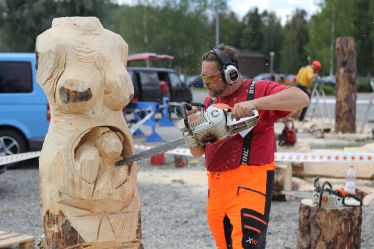
Chainsaw carvers have formed networks where they closely follow each other's work. Mutual communication is maintained through platforms like the ”Moottorisahaveiston fanit” ("Chainsaw Carving Fans") Facebook page, which has nearly a thousand followers. Carvers also meet each other at various events and carving courses held throughout Finland.
Various organizations and entities organize competitions and demonstrations for chainsaw carvers, allowing them to showcase their skills, compete, and socialize. A regular annual event is the Finnish Chainsaw Carving Championship, with the practical organizers changing from year to year, while the concept is overseen by Puunveistäjät ry (the Woodcarvers Association) A significant national contributor to the development of this field has been the Karhufestivaali event in Ilomantsi, established by the Association for Rural Culture and Education. The event, including a bear carving competition, began in 2014 as part of the international ”Puusta pitkään” ("The Many Faces of Wood") project funded by the EU's rural development program. From its early stages, the event focused on promoting carvers in media, raising awareness of chainsaw carving, and establishing international connections. Karhufestivaali (Bear Festival) and the sculpture park created in Ilomantsi's village landscape have been part of the European Heritage Days program for several years.One of the recent carving events includes the annual "Moottorisaha soikoon" (Let the Chainsaw Sing) competition held in Kivijärvi.
Chainsaw carving is practiced worldwide. International competitions are also organized within the discipline. Active countries include, among others, the Baltic countries, Germany, Italy, and the USA. There are long-standing traditions, such as the Carve Carrbridge event in Scotland. Sculpture events held in Tomsk, Siberia, have been among the largest international gatherings in the field. However, with Russia's initiation of the war in Ukraine, Western connections to the event have been severed.
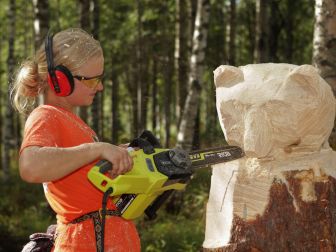
Practising of the tradition
Many chainsaw carvers possess strong skills in chainsaw handling and a deep understanding of wood characteristics, often based on their professions and backgrounds. The development and enhancement of a carver's skills are often influenced by the examples set by experienced carvers, as well as by keeping up with the continually expanding competition and event scene in the field and participating in carving courses.
Carvers have various values and preferences. Traditionalists primarily rely on using only the chainsaw, emphasizing the importance of creating sculptures from a single piece of wood without joints. Traditional carving competitions have often upheld this ideal. However, alongside these traditions, there has been innovation, liberation, and a departure from strict traditionalism. Many carvers use joints in their works to introduce diversity and motion to their figures. Additionally, some carvers prefer to finish the surface of their sculptures using chisels and sanding machines.
The technical treatment of wood sculptures involves protecting the surface with substances like wood turpentine, linseed oil, tar, or custom mixtures created by carvers. There are also various schools of thought and preferences in this regard. Some carvers accept only surface treatments that prevent decay, while others use colors or burn the sculpture's surface. Many carvers describe themselves as nature lovers, and this is reflected in their choice of subjects. Animal figures, especially bears, are absolute favorites. The bear's well-defined shape often serves as the starting point for many carvers. The bear inspires experienced carvers to create various interpretations, ranging from static, standing bears with one paw raised to highly expressive and lively sculptures. Other popular subjects include other forest animals like owls, foxes, capercaillies, hares, and even elk as the scale of the sculpture increases. What does chainsaw carving mean to its practitioners, and why do they do it? In the stories and interviews of carvers, the joy that carving brings is emphasized. It is the satisfaction of creating a wooden figure with one's own skills, sometimes achieving the planned result and sometimes being surprised by the outcome. Carvers find the challenge of carving fascinating, especially how to capture the movement and character of an animal.
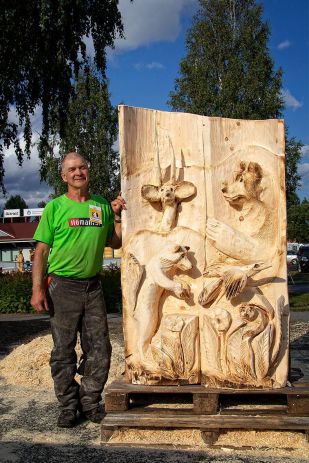
Raimo Hautaluoma, a farm substitute worker from Jalasjärvi, describes it as follows: "Although carving is physical work, much like substituting work, it is relaxing and calming. It frees your mind and gives you a good feeling. However, there may be weeks when you don't have time to carve. You shouldn't force yourself to saw, you have to have the right touch." Jari Rantanen from Kuhmalahti describes the allure of unpredictability: "While cutting, the work constantly takes shape, but it can also change multiple times during the process depending on the wood type, wood shapes, and branches." Both Eastern and American chainsaw carving traditions are often more ornate and detailed compared to the works of Finnish carvers. However, in recent years, the influence of international styles has been observed in Finland as well. For example, American-favored eagle motifs and totem-like sculptures are now prevalent in Finland too. Chainsaw carver Juha Käkelä has traveled extensively around the world, comparing different techniques and artistic expressions. After seeing how others achieved expressive results by using various hand tools in foreign carving competitions, he diversified his own toolkit. Käkelä states: "In bear sculptures, for example, Russians, Canadians, and Japanese have their own distinctive features. We Finns are a bit behind in that regard. We should catch up in terms of artistry, not just create stiff, upright bears."
The background and history of the tradition
Chainsaws became established in Finnish forestry during the 1950s but were initially very robust and heavy. In the 1970s, chainsaws became lighter, making it possible to use them for purposes other than just work-related tasks. A trailblazer in chainsaw carving in Finland was Paavo Tiihonen from Kerimäki, whose name is often mentioned in the conversations of older-generation carvers. Tiihonen sold tools for logging and came up with chainsaw carving as a way to showcase the chainsaws he was selling. According to oral tradition, Tiihonen's first sculpture in the late 1960s was a figure of a man. Tiihonen was a popular carver in the 1980s and 1990s. Known for his mastery of chainsaw use, Tiihonen used to say that he could even remove a speck of dust from an eye with it. The first significant event in the field occurred in the mid-1980s in Iisalmi with the inception of the Koljonvirta Chainsaw Carving Event, which continued until 2008, with chainsaw carver Erkki Rytkönen as a central influencer. The event brought together practitioners and developers of chainsaw carving traditions and served as a catalyst for many later carving competitions and events. The largest gatherings of carvers and audiences have been assembled since 2014 at the Ilomantsi Karhufestivaali, which has had up to 10,000 visitors at its peak. In the COVID-19 years of 2020-2021, the festival was held on a smaller scale, but during that time, for the first time, the carving event was live-streamed, reaching international viewers as well. The festival has also hosted competitions for the title of World Champion in Bear Carving for a few years, with Esko Heikura winning in 2014 and Markku Tuominen in 2017.
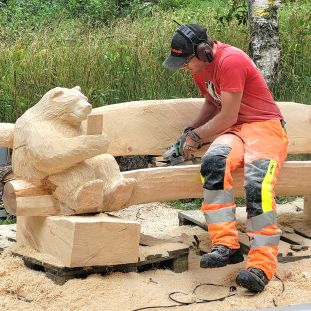
The most significant change influencing the practice of this tradition is that the equipment used for chainsaw carving has evolved, including the use of lightweight and efficient battery-operated saws and specially designed bars for carving. Today, almost all carvers finish their work using battery and electric tools. Environmental consciousness has introduced requirements for the use of ecological fuels and chain oil, particularly in competitions. Safety measures have also gained increased attention.
Another notable change is the widespread availability of chainsaw carving courses throughout Finland. These courses attract more hobbyists to the field, individuals who may not aim for competitions but want to learn chainsaw carving for their own enjoyment and to create sculptures for their own yards.
The transmission of the tradition
Experienced carvers in the field have been helpful in passing on their skills and mentoring young and beginner carvers. Learning occurs through observing the actions of experienced carvers and participating in carving competitions and courses in the field.
Among the experienced carvers who have generously shared their knowledge to develop the tradition, in addition to Paavo Tiihonen, one can mention individuals like Hannu Kyllönen, known as the "Pölökynveistäjä" from Kuhmoinen, whose name is frequently mentioned by many carvers as a role model and source of inspiration. Multiple-time Finnish champion Arvo Hietala from Kangasala is also recognized as an inspiration. In PuuhaMaa sculpture park in Villähde, Lahti, Leo Laakko and Kari Onninen have provided guidance to newcomers. Markku Tuominen from Nurmijärvi has also offered guidance to younger carvers. Many experienced carvers have passed on their skills through a master-apprentice principle.
The most well-known chainsaw carver currently offering carving courses is Juha Käkelä from Ylöjärvi. He organizes courses throughout the year in different parts of Finland, and private instruction can also be arranged with him. Käkelä has significantly emphasized improving safety measures in his work and has introduced entirely new participants to the field.
Chainsaw carving can also be learned through online materials. The online school by the Association for Rural Culture and Education offers a comprehensive, free chainsaw carving course. There is also a wealth of chainsaw carving content available on YouTube. Several English-language instructional books on the subject have been published.
A crucial avenue for passing on traditions and developing skills in the present day is social media. Many carvers are actively engaged online, sharing images of their carvings and engaging in discussions with each other. Some have also established websites or image galleries.
The future of the tradition
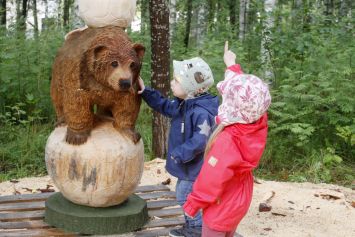
Chainsaw carving in Finland is a lively and growing tradition that is gaining increasing popularity among both chainsaw carvers and the general public. New chainsaw carving events and carving-related initiatives are organized in various parts of Finland.
Chainsaw carving as an art form enriches and enlivens rural communities, brings visibility to villages, and attracts visitors to events. Chainsaw carving performances are part of the program at many trade shows and events. Chainsaw carvers have been invited to rural villages to create sculptures in collaboration with the local community, and they are also commissioned to create public sculptures. Chainsaw carving is now also being seen in urban environments, such as the transformation of felled lime trees from Tampere's tram project into works of art.
Some chainsaw carving practitioners have established businesses or companies and have found opportunities for success through product development, corporate partnerships, course activities, and expanding their target audiences.
The community/communities behind this submission
Association for Rural Culture and Education
ITE-taiteen kannatusyhdistys - ITE ry
MSL:n Vaara-Karjalan kulttuuriyhdistys ry
Bibliography and links to external sources of information
Practitioners web pages
FB-ryhmä Moottorisahaveisto fanit
Puunveistäjät ry:n SM-kilpailujen tuloksia vuodesta 1986
Moottorisahaveistoksia, Finna, ITE-taiteen portaali
Online teaching material
Moottorisahaveiston kurssimateriaali Maaseudun Sivistysliiton verkko-opistossa. Juha Käkelä ja Jani Grönlund, 2020.
Ohjeita puuveistoksen hoitoon MSL 2014
Videos
JG-woodcrafts, Jani Grönlundin videoita
Chainsaw carvers introductions and articles
Pertti Karhunen muistelee Paavo Tiihosta.
Pölökynveistäjä Hannu Kyllönen
Raimo Hautaluoman veistäjäesittely
Jari Rantasen veistäjäesittely
Chainsaw sculptures
Tuhannen karhun maa -veistospuisto
Arboretum Mustilan veistospolku
Leo Laakon ja Kari Onnisen PuuhaMaa
Kuusamo-opiston moottorisahaveistokset
Chainsaw carving events
YLE Egenland 3.4.2019, Ilomantsin Karhufestivaali
radiosun 13.8.2019 Tampereen Ratikan taidehanke
YLE 29.6.2020, Mustilan arboretumin veistospolku
Seura 22.1.2023, Kaupunkipuu taideteoksena -veistotapahtuma
Moottorisahaveistäjä kylätaiteilijana, MSL 2023 [1]
Bibliography:
Puumorsian, Kokko T., 2007.
Relief Carving, Wood Spirit. Irish, L.S., 2013.
Art of Chainsaw Carving. Groeschen, J., 2014.
Chainsaw Carving Beginners. Tschiderer, H., 2022.
The Book of Wood Carving: Technique, Designs and Projects. Sayers, C., 1978.
Chainsaw Carving an Eagle: A Cpmplete Step-by-step Guide. Doeren, J. & Roghair, D., 2005.
Interviews
Juha Käkelä, Ylöjärvi, puhelinhaastattelu 13.3.2023, Raija Kallioinen
Erkki Rytkönen, Iisalmi, puhelinhaastattelu 13.3.2023, Raija Kallioinen
